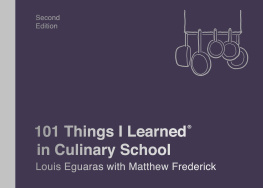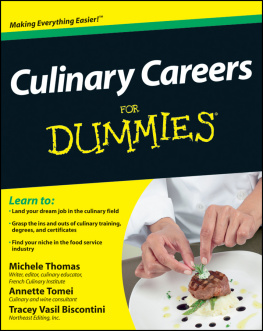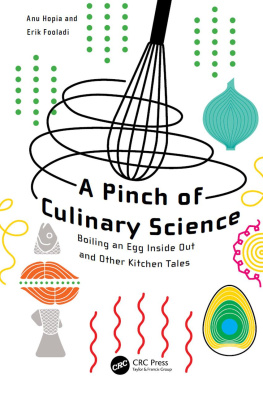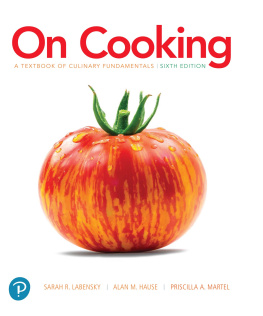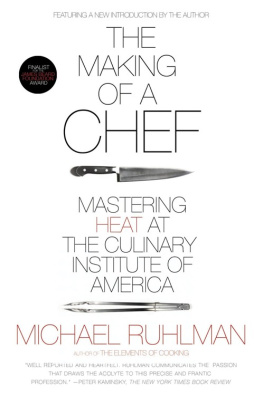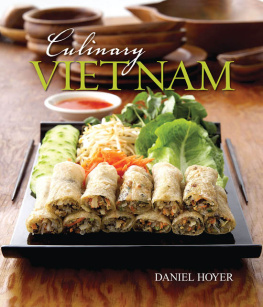Contents
Landmarks
Print Page List
Acknowledgments
From Louis
Thanks to my mother, Maridel Gonzalez-Beckman; my stepfather, Kent M. Beckman; Steve Brown; Stephen Chavez; Jeffrey Coker; Mark Diamond; Ronald Ford; Monica Garcia-Castillo; Peter George; Martin Gilligan; Herve Guillard; Simon Harrison; Keith Luce; Mike Malloy; Jayson McCarter; Roland Mesnier; John Moeller; Glenn Ochi; Patrice Olivon; Mike Pergl; Mauro Daniel Rossi; Lachlan Sands; Walter Scheib; Mike Shane; Paul Sherman; Trinidad Silva; Richard Simpson; Rick Smilow; Robert Soriano; Bruce Whitmore; Matthew Zboray; my chef instructor colleagues, who appreciate the simple explanation of culinary techniques and terminology; my students for being a resource of what to present in this book; the United States Navy; and, most importantly, my beautiful wife and best friend, Agnes Castillo Jose-Eguaras.
From Matt
Thanks to Ty Baughman, Sorche Fairbank, Matt Inman, and Josephine Proul.
Other books in the 101 Things I Learned series
101 Things I Learned in Advertising School
101 Things I Learned in Architecture School (MIT Press)
101 Things I Learned in Business School
101 Things I Learned in Engineering School
101 Things I Learned in Fashion School
101 Things I Learned in Film School
101 Things I Learned in Law School
101 Things I Learned in Urban Design School
Authors Note
Since the first edition of this book was published, the culinary world has evolved at a remarkable pace, thanks largely to the growth of food-related websites, television programs, recipe generators, cooking apps, prepared meal delivery systems, andwe like to thinkbooks like this one.
A field that has always demanded the mastery of so much information and so many skills has gotten even more complicated. When there is so much to learn, where does one begin?
Right here. We have packed this new edition with useful advice, hard-earned wisdom, and informational frameworks to get you started in the kitchenor maybe more accurately, to prepare you to start. Whether you are buying pots, selecting potatoes, or grilling a porterhouse, this book will help you figure out what is most important to know, and will help organize your learnings.
If you are an experienced cook, you will find within many reminders and insights that will keep you grounded in best practices. And if you are pursuing a career in the field, you will learn about critical aspects of the culinary professionhow chefs think and conduct themselves, how a professional kitchen works, and the terminology and procedures that keep a restaurant running smoothly.
Like the first edition, this is not a recipe book. While it will teach you a bit about how to cook, more than anything we want it to help you get ready to cook. So keep this small volume in the kitchen for reference. Or put it on your coffee table, in your toolbox, or in your jacket pocket to peruse in your free moments. It can be read randomly, so dip in anywhere at any timebetween classes, on the bus, or while waiting for water to boil. Use it as a friendly reminder and refresher. And now that you have this second edition in hand, feel free to use the first edition as a coaster.
Louis Eguaras and Matthew Frederick
Louis Eguaras is department chair at the Culinary Arts Institute at Los Angeles Mission College, Chef Instructor at the Institute of Culinary Education, and a former White House chef. He has cooked for two U.S. presidents and numerous dignitaries and celebrities, including Nelson Mandela, Tom Hanks, Anthony Hopkins, and the Rolling Stones. He lives with his wife in Newport Beach, California.
Matthew Frederick is an architect, urban designer, instructor of design and writing, and the creator of the 101 Things I Learned series. He lives in New Yorks Hudson Valley.
There are only two ways to cook.
Dry cooking directly exposes food to heat, using radiation, convection, or oil. Methods include sauting, pan-frying, deep-frying, grilling, broiling, roasting, and baking. It produces browning or searing of the foods surface.
Moist cooking transfers heat to food via immersion in water or a water-based liquid, such as milk, wine, or vegetable stock. Methods include boiling, simmering, poaching, and steaming. Foods are not browned and are usually tender when done.
In sous vide (soo veed, French for under vacuum), a food is sealed in plastic or glass and heated for a long time in hot water. This makes it an in-between method in which the water does not contact the food despite being the heating medium. In braising and stewing, dry and moist cooking are typically combined by first searing meat with dry heat, then simmering it at length in liquid.
Dont buy a matched set of pots.
Cast iron: Very heavy, which allows it to heat evenly and maintain very high temperatures, making it ideal for browning/searing. Durable, but reactive to acids, thus requiring frequent seasoning (a protective layer of fat and carbon) to prevent rust. Enameled cast iron does not have to be seasoned, but it can chip and discolor.
Stainless steel: Lightweight, nonreactive to acids, and not a good heat conductor. Make sure a layer of aluminum or other highly conductive material is included in the pot base to promote heat transfer.
Aluminum: Lightweight, inexpensive, and a good heat conductor, but reactive to acids and easily dented. Anodized aluminum is less reactive and more durable.
Carbon steel: Durable, heats quickly, requires regular seasoning. Good for woks, paella pans, and crpe pans.
Copper: Best conductivity and most even heating; responsive to temperature changes. Expensive, reactive to acids, tarnishes quickly. Popular for making sauces and sauting.
A griddle is not a grill.
Griddle: a heavy piece of cooking equipment with a continuous flat heating surface. Often used for pancakes, eggs, omelets, cheesesteaks, and other diner-type foods.
Grill: an open web that allows food to be directly exposed to fire. Most useful in cooking meats and some fish and vegetables.
Saucepan: has a squared cross section, used for basic heating and boiling.
Saucir: has a tapered cross section and rounded bottom, suiting it to preparing sauces, custards, risotto, and other creamy foods, as there are no corners in which food can hide and burn. Additionally, its shape accommodates whisking.
Skillet: has low, flared sides that help dissipate moisture. It is useful for pan-frying, browning/caramelizing, and reducing sauces. The sloped sides make it easy to flip food and slide it out when done.
Saut pan: useful for pan-frying but has straight, high sides and a lid to reduce splatters and keep in heat and moisture. Especially useful in combination cooking, for example when pan-browning a food before transitioning to moist cooking.
A restaurant kitchen is a military operation.
A restaurant kitchen is not a professional version of a home kitchen. It is a highly ordered production system in which all activities are interrelated. Every food item and scrap has a plan. Every dish is prepared with a specific outcome in mind, to match the vision of the head chef. Success requires strict adherence to the chain of command established by the kitchen brigade system.

